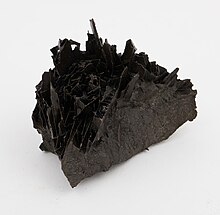 Iron carbide plates
| |

| |
| Names | |
|---|---|
| IUPAC name
Iron carbide
| |
| Other names
Cementite
| |
| Identifiers | |
3D model (JSmol)
|
|
| ECHA InfoCard | 100.031.411 |
| EC Number |
|
CompTox Dashboard (EPA)
|
|
| |
| |
| Properties | |
| Fe3C | |
| Molar mass | 179.546 g/mol |
| Appearance | dark gray or black crystals, odorless |
| Density | 7.694 g/cm3, solid[1] |
| Melting point | 1,227 °C (2,241 °F; 1,500 K)[1] |
| insoluble | |
| Structure[2] | |
| Orthorhombic, oP16 | |
| Pnma, No. 62 | |
a = 0.509 nm, b = 0.6478 nm, c = 0.4523 nm
| |
Formula units (Z)
|
4 |
| Thermochemistry[3] | |
Heat capacity (C)
|
105.9 J·mol−1·K−1 |
Std molar
entropy (S⦵298) |
104.6 J·mol−1·K−1 |
Std enthalpy of
formation (ΔfH⦵298) |
25.1 kJ·mol−1 |
Gibbs free energy (ΔfG⦵)
|
20.1 kJ·mol−1 |
Except where otherwise noted, data are given for materials in their standard state (at 25 °C [77 °F], 100 kPa).
| |
Cementite (or iron carbide) is a compound of iron and carbon, more precisely an intermediate transition metal carbide with the formula Fe3C. By weight, it is 6.67% carbon and 93.3% iron. It has an orthorhombic crystal structure.[4] It is a hard, brittle material,[4] normally classified as a ceramic in its pure form, and is a frequently found and important constituent in ferrous metallurgy. While cementite is present in most steels[5] and cast irons, it is produced as a raw material in the iron carbide process, which belongs to the family of alternative ironmaking technologies. The name cementite originated from the theory of Floris Osmond and J. Werth, in which the structure of solidified steel consists of a kind of cellular tissue, with ferrite as the nucleus and Fe3C the envelope of the cells. The carbide therefore cemented the iron.
- ^ a b Haynes, p. 4.67
- ^ Herbstein, F. H.; Smuts, J. (1964). "Comparison of X-ray and neutron-diffraction refinements of the structure of cementite Fe3C". Acta Crystallographica. 17 (10): 1331–1332. Bibcode:1964AcCry..17.1331H. doi:10.1107/S0365110X64003346.
- ^ Haynes, p. 5.23
- ^ a b Smith & Hashemi 2006, p. 363
- ^ Verhoeven, John D. (2007). Steel Metallurgy for the Non-Metallurgist. ASM International. p. 35. ISBN 978-1-61503-056-9.